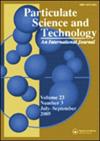基于改进的YOLACT网络的输送带对中视觉检测方法
IF 1.5
4区 工程技术
Q3 ENGINEERING, CHEMICAL
引用次数: 0
摘要
摘要传送带失中是许多带式输送机系统的运行和维护问题,可能导致严重的停机和设备故障。本文提出了一种基于实时实例分割的皮带错位视觉检测方法。讨论了一种改进版的You Only Look At coefficient (YOLACT)网络,对原有YOLACT网络的特征骨干网进行了优化。利用改进的YOLACT网络,对不同体积固体组合和运行条件下的皮带错中进行了实验检测。结果表明,改进后的YOLACT网络的检测精度达到了86.05%的mean Average precision (mAP),其中对mAP的改进最大的是FPN修改,比使用ResNeXt-50的YOLACT网络提高了1.75%。在检测速度方面,改进的YOLACT网络(15.19 Frames Per Second [FPS])优于Mask R-CNN (3.42 FPS)和MS R-CNN (3.41 FPS)。此外,从测试的平均检测误差为0.74 mm的皮带装载不同的散装固体。结果表明,应用改进的YOLACT网络对输送带错中实时检测是有效的。关键词:输送带错位视觉检测特征主干改进YOLACT披露声明作者未报告潜在利益冲突。项目资助:国家自然科学基金资助项目(批准号:No. 102no .)基金资助:52202500)和武汉理工大学海南学院(批准号:52202500);: 2021 kf0028)。本文章由计算机程序翻译,如有差异,请以英文原文为准。
A visual detection method for conveyor belt misalignment based on the improved YOLACT network
AbstractConveyor belt misalignment is an operational and maintenance issue for many belt conveyor systems and can result in significant downtime and equipment failure. This article presents a visual detection method for belt misalignment detection using real-time instance segmentation. An improved version of the You Only Look At CoeffcienTs (YOLACT) network is discussed, where the feature backbone of the original YOLACT network is optimized. The improved YOLACT network is used to experimentally detect the belt misalignment with different combinations of bulk solid and operating conditions. The results show that the detection precision of the improved YOLACT network achieves 86.05% mean Average Precision (mAP), in which the greatest improvement on the mAP is the FPN modification with an increase of 1.75% compared to the YOLACT network with the ResNeXt-50. In terms of the detection speed, the improved YOLACT network (15.19 Frames Per Second [FPS]) outperforms the Mask R-CNN (3.42 FPS) and the MS R-CNN (3.41 FPS). Moreover, the averaged detection error from the tests is 0.74 mm for a belt loaded with different bulk solids. It can be concluded that the application of the improved YOLACT network is effective for the real-time detection of conveyor belt misalignment.Keywords: Conveyor belt misalignmentvisual detectionfeature backboneimproved YOLACT Disclosure statementNo potential conflict of interest was reported by the author(s).Additional informationFundingThis work is financially supported by National Natural Science Foundation of China (Grant No.: 52202500) and Hainan Institute at Wuhan University of Technology (Grant No.: 2021KF0028).
求助全文
通过发布文献求助,成功后即可免费获取论文全文。
去求助
来源期刊

Particulate Science and Technology
工程技术-工程:化工
CiteScore
4.40
自引率
4.00%
发文量
86
审稿时长
12 months
期刊介绍:
Particulate Science and Technology, an interdisciplinary journal, publishes papers on both fundamental and applied science and technology related to particles and particle systems in size scales from nanometers to millimeters. The journal''s primary focus is to report emerging technologies and advances in different fields of engineering, energy, biomaterials, and pharmaceutical science involving particles, and to bring institutional researchers closer to professionals in industries.
Particulate Science and Technology invites articles reporting original contributions and review papers, in particular critical reviews, that are relevant and timely to the emerging and growing fields of particle and powder technology.
 求助内容:
求助内容: 应助结果提醒方式:
应助结果提醒方式:


